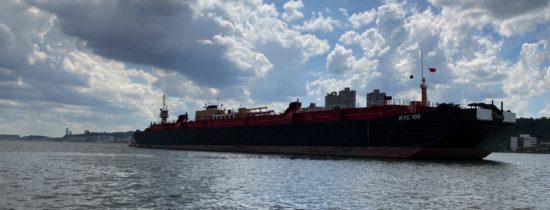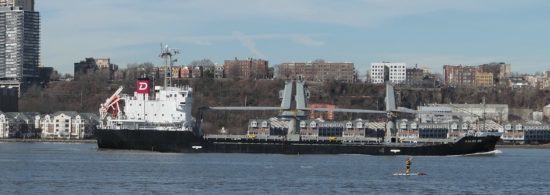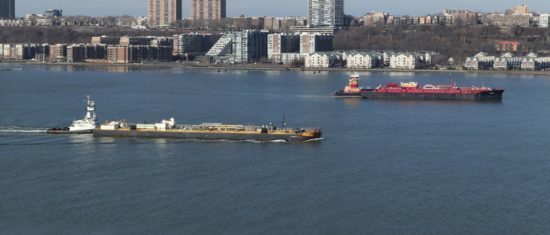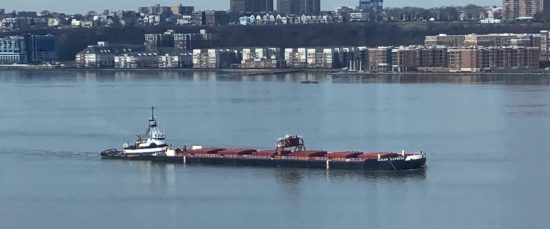By Daniel Katzive
If you have spent any time at all in Riverside Park, you will no doubt have noticed the tugboats and barges that anchor in the Hudson River regularly.

They float against their anchor lines, with their sterns (back ends) facing downriver towards the harbor when the tide is ebbing; then swing around to face the opposite direction, with their sterns toward the George Washington Bridge when the river begins to flood again. For short periods, as the tide slacks (stills), usually four times per day, they sit perpendicular to the river, and you can see over their sterns or bows from the shore.
Have you ever wondered why they are anchored there, what they are for?
You’ll see many types of commercial vessels traveling the Hudson River throughout the year, serving as vital cogs in our regional economy. You’ll see tugboats pushing barges full of cement coming down from the Lafarge plant in Ravenna, New York, or barges full of sugar being brought up from Florida to be refined and packaged in the Domino Sugar plant in Yonkers.

Tugboats push or pull lashed-together groups of open-topped hoppers full of stone and gravel from quarries near Poughkeepsie. Barges full of used paper products are nudged out of the Sanitation Department’s 59th Street Transfer Station and brought to recycling facilities in Staten Island.
You’ll also see cargo vessels that are not barges at all. New York City owns a fleet of small tankers that ferry sewage sludge for processing between various plants, including the North River plant near 135th Street.
Larger foreign flagged bulk carriers also bring cargo from overseas up the river heading for Albany or the port town of Coeymans. They carry wood pulp from Sweden for paper mills and, heading for Yonkers, sugar from other foreign ports. Small foreign flagged tankers may also occasionally travel up the river, carrying oil products or chemicals from refineries in Europe or New Brunswick, Canada.
Note: foreign flagged vessels can bring cargo from abroad and pick up U.S. cargo heading to foreign ports, but they cannot carry cargo between U.S. ports because of a law known as the Jones Act. Cargo which travels between U.S. ports must almost always be on U.S. flagged vessels, and the vast majority of these are tugs paired with barges.

You will see all these types of commercial vessels passing by on the river, but most of them rarely or never anchor. The barges you see anchored are almost always oil-product tanker barges, and almost always empty.
You can tell they are empty because they sit very high in the water with their decks towering above the river. Loaded oil-product barges will sometimes pass by on the river, heading to terminals up north, and you will notice these sit very low in the water. They do not typically anchor in the river while loaded.

The location of the anchorages is not random. Rather, the area between 72nd Street and the George Washington Bridge is designated by the Coast Guard as a zone where these vessels are allowed to anchor. A spokesman for the US Coast Guard’s Sector New York responded to questions from WSR via email, noting that the Coast Guard “actively monitors” all vessels using the anchorages in the river from its base on Staten Island, but there is no requirement for tugs to reserve a spot on the river and there is no charge for parking.
Most tugs we see anchored in the river stay for a relatively short time, often less than 24 hours, and the Coast Guard normally limits anchoring in the Hudson to a maximum of 96 hours. One particular tug-and-barge combination has been anchored off West 94th Street for much longer this winter, but, according to the Coast Guard, this is an exceptional case due to particular operational circumstances.

So, what are empty tanker barges doing, anchored in the middle of the river with their attendant tugboats and crews? Simply put, they are waiting for cargo to be assigned to them and berths to open up for loading the cargo. Captain Eric Johansson, a professor at SUNY Maritime Academy who works with the towboat industry in New York Harbor, pointed out to WSR that in years past, tugs and barges might wait tied up at docks on shore, but with dock space more limited now, anchoring in the river or the harbor is the best option for these vessels.
When a cargo is ready, the tugboats will usually bring their empty barges south to loading points on the New Jersey shore, usually in the narrow body of water facing Staten Island called the Arthur Kill. As anyone who has driven along the New Jersey Turnpike knows, that section of New Jersey has some large oil refineries. A number of major oil product pipelines running up from the Gulf of Mexico also terminate in this area.
There are no major oil refineries in the northeast US north of New Jersey and east of western Pennsylvania, despite the large population living up in New England. Pretty much all the oil products consumed in the northeast, including gasoline, diesel fuel and heating oil, must either be brought up from the Gulf of Mexico area by pipelines which terminate in New Jersey, refined in New Jersey, or shipped in from New Brunswick Canada or Europe. To get crude products from North Jersey to most distribution points in New England requires it being shipped by truck, train, or…barge.

Captain Johansson of SUNY Maritime points out that a single barge can carry much more than a tanker truck or rail car. He stressed that the safety record for these vessels has been good, and that the companies have made big investments in safety and are working towards reducing emissions as well.
So where do the barges go after they fill up with diesel, gasoline, or heating oil down along the Arthur Kill? Some will motor back up the Hudson, heading for distribution points in Albany or Newburgh where the cargo is transferred to trucks or rail cars. Others will leave New York Harbor and travel up the Long Island Sound, heading for ports such as New Haven, Boston, Providence, or Portland, Maine. When they have unloaded, they return to New York empty and, if no new cargoes are immediately available, they will head back to anchorages…to wait.








Would love to know more about the Standup Paddle Boarders and Kayakers that go out in the Hudson.
Many depart from Pier 84 (just south of the Intrepid Museum.). Manhattan Kayak Company.
There are also Outrigger Canoes that depart from Pier 66 (near 24th street.)
This site will tell you what ships are in our area. Very informative, and useless….
https://www.marinetraffic.com/en/ais/home/centerx:-73.983/centery:40.779/zoom:13
I really enjoyed this, thanks!
So informative. Thank you.
Fascinating and well-written article. Without these vital services, New Yorkers would learn in hurry what it’s like to live in Venezuela.
All these years and I had NO ideas what was in those barges Incan see from my window! My question is, why aren’t there more sail boats on the uptown part of the Hudson? They all seem to be in the estuary.
The currents up there are wicked and dangerous for sailboats. Also, although sailboats are supposed to have right of way over powerboats, they must give way to any commerical ship. Just too much traffic in too narrow a space to make sailing fun.
I sail with Hudson River Community Sailing both at their Chelsea location and way uptown in their growing Inwood location, and sometimes from one to the other. Yes, currents and traffic present challenges, but a lot of us find that a part of the fun. Plenty of excitement, amazing views, and even fascinating wildlife. A great place to learn, hone skills, and teach new sailors. They say once you’ve gotten the hang of sailing on the mighty Hudson, everything else will come easier.
This was great, thank you.
West Harlem Piers Park on W125Th street needs to repair all of its piers and docks damaged in previous storms.
Very informative. Articles about the infrastructure that supports us are a welcome addition to the newsletter.
Thanks for this article, Daniel! My husband was a British merchant sailor for 17 years. He reads the WSR but I’ll share this article with him anyhow.
Thanks! We’ve wondered about this for years as we look to the Hudson from the 10th floor on W113th Street. This article is very helpful
If you want to get deeper into the shipping weeds (not only here in NYC but worldwide) there is an app: VESSELFINDER. It allows you to identify name of vessel, type of vessel, size, and flag.
“One particular tug-and-barge combination has been anchored off West 94th Street for much longer this winter…” Yes, I’m sure this is the one I see every day that’s been anchored now into its 4th week — a real anomaly!
BTW, what the heck is the tugboat crew doing all this time???
Well done. Very interesting.
How about more info on the anchoring mechanism. How deep is the water? What is the shape of anchors? How many are used? Do they ever get stuck (as the one on my boat has). Etc
The river is about 40 to 50 feet deep in the channel. I have not heard of anchors getting stuck in the mud. I know they do have powerful winches to raise them.
This was very informative and interesting. Thanks for doing this feature.
When barges are anchored out there, how many people are aboard? I always feel sorry for those cold, lonely souls.
I believe a typical tug crew is 5 people (captain, mate, engineer, and two deckhands) but there may be additional crew on board involved with managing the barge and cargo. The Coast Guard did confirm to me that the tugs are always fully manned while at anchor. I believe they are busy with maintenance while at anchor. I did once see a man in sweats running laps around the barge, but only once.
I also enjoyed this article and learned something, thank you!
Wow! We see the combination tug from our West 95th Street window and have started each day–or ended–wondering if it was a floating lighthouse. Thank you!!!
Thanks for the article!
What an interesting article. Thanks.
There is a much less innocent issue with these tugs. Most of them have long burnt “bunker oil” for fuel. Bunker oil is the used engine oil from diesel trucks and automobiles. It is extremely dirty fuel, and has been regarded as one of the reasons African American youth (and adults) in Harlem have such high rates of asthma.
Many years ago a tug was idling west of 105th and there was a west wind blowing all its exhaust into Riverside Park. I couldn’t breathe. Managed to call 311 to complain about the tug and they asked me what street it was on. I explained it was a tug in the Hudson River. Boats don’t use streets.
Beautifully written. Almost poetic.
What are the operational circumstances regarding the 94 st barge? It’s seemsto have been there for months
What a marvelous article! Thank you for explaining the very essential activities of these tugs and barges that most of us knew little about even though we see them every day. Great journalism! Let’s have more articles like this one.
What a very informative article. Now, I will know what those barges are doing in the Hudson River.
Now, how about an article on why we are now experiencing more planes and helicopters flying over the upper westside?
How refreshing to have something a bit novel in the hopper. Almost like an “anti-bandwagon” story.
Ahhhhhh…..
Thanks!
What a fantastic article, Thank you so very much.
Thank you for this story about the barges
in the HUdson! I admire the mighty Tugs carrying them up the River. A sight to see!
Hats off to Daniel for such an informative and well-researched piece. And let me add my thanks to the editor who assigned it and the person who first came up with the story idea.
It’s nice to see neighbors agreeing on something in the comments section–a rarity these days given all that is going on in the UWS.
I’ve been shooting this subject for 6 years from a 10th flor window at RSD /109th St, got over 5000 images now.
Wow ! great article, I just printed a book on this subject this past month: Action Along the Hudson River. 116 pigs, 303 photos 8×10 soft cover format.
Thanks, I’ve been looking at these barges for many years and wanting to know what was going on.
The tug/barges anchored in the middle of the Hudson create a major problem for the W. 79th Street Boat Basin. Even though the anchorage extends to the NJ shore,most of the tugs anchor at the boundary in the middle of the river next to the ship channel. On some current shifts, the tug/barges will swing into the ship channel.
Underway vessels are being squeezed toward the Boat Basin where the vessel wakes injure boaters, damage boats and tear up the docks and ramps. This problem should be addressed before the re-built Basin is opened.
The Jones Act requires goods moving between USA ports to be moved on US Flag ships at 3 times the cost of regular market ships.The reasons given are security and the need to maintain a merchant navy.During the 1991 Iraq war,President Bush discovered that the USA did not have any ships capable of shipping required supplies and materiel to his forces and had to use regular ships who upped their rates tremendously.Oil from Alaska to the lower states travels exclusively on US Flag ships at great cost to the public.This should stop
Great article, Dan. As a regular visitor to the Upper West Side, I have always been fascinated by the comings and goings of the industrial barges on the Hudson. Any comment on the general fiscal health of this industry? I always figured the barges go the way of streetcars past and disappear from view, but they have endured year after year.
As was hinted at in the article, water-borne transportation is the cheapest method of moving large quantities of bulk cargo, whether petroleum products, cement, or agricultural commodities. Barges and cargo ships will never go out of style because of this.
There is a book in this somewhere, David, for more courious UWS minds; particularly in the near future as energy production/distribution complexities and costs subject to geopolitical reverberations. Thanks for the high calibre reportage.
Working for Moran Towing &Transportation Company for 21 years was the best job I ever had . Started as a deckhand to dispatcher to Marine Superintendent . It’s an awesome job but it is also extremely dangerous.
My father also worked for Moran as a docking pilot.
Thank you for your very clear and informative article. I would have liked a more detailed explanation, however, beyond “particular operational circumstances” as to why the one combination tug (Teresa) and barge (Acadia) has been anchored in the same spot off W. 94th Street for over a month. Most of the tug/barge combinations that shuttle up and down the Hudson are registered in New York; this long-time visitor, Teresa/Acadia, is registered in Liberia. There must be a story here.